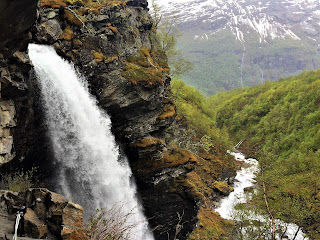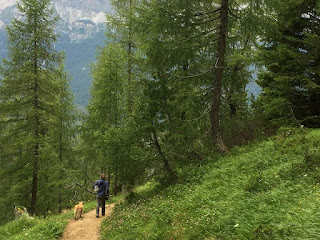This time, I’ve been during a full summer season at the Norwegian fjords, more specifically at the small village of Geiranger, working as a kayak guide and exploring the surroundings on my free time. Here is a short summary about my experiences and impressions around the incredible scenario of the Geiranger Fjord…
Geiranger (means: ‘arrow shaped fjord’) is a small village of some 150
people in the winter/500 people in the summer (due to the affluence of seasonal
workers) located at the very end of the 16 km long (and 250 meters deep) Geiranger
fjord, the last branch of the 100 km long Sunnylvsfjord that penetrates the land
by Ålesund. The protected area that includes the village of Geiranger, the
Geiranger fjord and the mountains to the north of it (and part of the Norddalsfjord)
was declared Unesco’s natural patrimony (one of 15) in 2005 for its intrinsic value
to humankind.
Location: north of the glaciers of the Jotunheimen National Park; 100 km
east of Ålesund (nearest airport); 650 km north of Bergen; 8 hours’ drive to
the northwest of Oslo.
What to do: besides running the fjord on a kayak (better than on a rib
boat or a ferry boat) to see the waterfalls (the big 3 are: ‘7 sisters’; ‘Suttor’
and ‘Bringa’) or drive up to the Flydalsjuvet (4 km up the east road) or the Dalsniba
(21 km up the east road) viewpoints, the most popular activities are hiking and
tasting the local specialties: beer; chocolate; moose burger. Other
possibilities lay at 45 km (north-east), with the impressive zig zag road or
Trollstigen, offering great views and hike opportunities; at 87 km (north-east),
by the Åndalsnes town, with hiking trails and a famous ridge; at 50 km (south),
with the Stryn summer ski resort (open mid-June and July), or (at 65 km) the
town of Stryn itself, and Loen (some 11 km more), with its skywalk (gondola to
a peak with views to the glaciers) and daring Ragnar via-ferrata… Other ideas might
arise from watching my 5 minutes video on UTube: https://youtu.be/sJpMznGllDw
Highlights: the ‘7 sisters’ waterfall, an amazing fall from 410 meters
high that splits into seven fingers; the Dalsniba viewpoint, the highest road
in Scandinavia with a view to a fjord, and what a view! You can drive directly
there but have to pay around 25€ for the last 5 km (not payable if walking or
biking); Zipline course (one hour of family accessible via-ferrata and zipline course
that goes next/over a water fall).
Hiking: mountains around here are not very high (varying from around 1.300
to 1.700 meters high) but, as one starts most hikes almost around the sea
level, the accumulated height gain is quite high. So, before coming here, you
better train a lot by walking upstairs… The Information/Ticket Office in front
of the port will tell you the several options (opens from 9-17h00). There is
also a big and detailed map right in front of the UNESCO Fjord Center (opposite
to the Union Hotel), on the upper part of the village. One of the most popular
trails is called Storsaeterfossen (‘fossen’ means: waterfall) and it will take
you about over one hour uphill to reach a waterfall where you can walk behind
the drop. Take seriously the marks for each trail (blue is easy; red is hard;
black is very hard or technical): if you are not experienced, even the ‘easy’
trails could turn to be a hard surprise. Norwegians in general are very use to
hiking therefore their ‘measures’ might not apply to people not use to steep and
irregular trails. Also, the trails are very poorly (or not at all) maintained,
meaning that you will probably find very wet, muddy and stony trails that
require good foot wear, attention and security in moving on slippery and irregular
ground; and sometimes the marks (usually a red ‘V’ painted on rocks) will be
missing when you most need them (especially closer to the summits). Most of the
shorter trails are never circular which is a shame because one needs to walk back
on the same trail (for the longer trails there are more options but you need to
organize logistics to be dropped off or picked up). A good alternative for smoother
hikes with also some nice views lies around the lake Kilstivatnet (‘vatnet’
means: lake), close to the village of Eisdal, 25 km to the north of Geiranger.
Impressions: some described those landscapes as the ‘tropic forest of
the north’, as the ‘wet paradise’ or as a ‘Switzerland on steroids’, not that
the Swiss mountains are smaller but in a way that the fjord landscape is more
dramatic with the steep and dark rock faces falling straight down on the water
at sea level.
Some say the Norwegians try to get money ‘from under the stones’,
meaning they are charging for everything and too much (on a ferry tour they
were charging the same price to a months old baby as to an adult!). This
applies in Geiranger, like the toll for the last 5 km on the Dalsniba road, but
also to the exaggerated number of tolls on roads that are not highways nor fast
roads (E06 and E136) and you need to drive through to get there.
If you spend time enough in Geiranger you will get to know that all the
businesses in the village belong to the same five families, in a tight and weird
contact web that seems to rule and govern as an oligarchy, and perhaps explains
why the local mentality is so closed to outsiders (a foreign business will have
a hard time to settle or even start) if it wasn’t for the majority of foreigners
(outside workers).
Prices: at the supermarket? Just crazy (there is only one supermarket in
Geiranger, the ‘Joker’) … Take a lot of your own food if possible! Prices in Norway,
in general, are high, but in Geiranger they are higher! The tours on the sightseeing
ferries are also overrated (not good value for the money).
Secrets: the moose burger with french fries at Brygg (next to the
bakery, at the village walking zone); vegetarian options also available; alternatively you can drive to the mountain
hotel ‘Høyfjells’ at Grotli (37 km direction east) and get a better deal there.
The restaurant Posten is very good too (they have a salmon burger) but very
expensive. Try the local ‘Geiranger beer’ with blue berries (costs around 5€ a
bottle at Joker) and get informed about the story behind it (lady Bringa brewed
it first like that, in the early 1900). My favorite of the 5 sorts was the ‘pale
ale’. Try also the ‘Geiranger Sjokolade’, the local chocolate factory (own
production) with a cozy terrace located on the walking street.
Stay: at the amazing Grande Hotel (also the more expensive but not
better Hotel Union); many cabins/huts possibilities available (being the best
located, probably, the ones belonging to the coffee place Hole (3 km higher up
the village); two camping sites (one at the water front and the other higher up,
next to a water fall). Book any of these quite in advance if going on the high
season (July-August).
Weather: generally rainy! When the sun comes out it can get
really warm (even inviting to jump in lakes or the fjord). Average temperature
in July is 14º C! Get informed on the forecast (www.yr.no) but even that is not
always as accurate as desired. Norwegians have a lapidary ‘saying’, though:
there is no bad weather, just bad clothes!
When to go: to see the waterfalls, better to go in June,
when those still carry a strong volume of water and the mountain tops are still
covered by a white snow cap; to hike, better end of August/beginning September,
when there are more chances of the rain water to drain and the terrains to get
less wet. But, of course, Norway is Norway and the weather is never stable or to
be trusted. Because of that (I got light snowfall in August, at 1600 meters
high), and remembering that ‘saying’, good mountain boots and good trousers and
rain jacket are a must on any hike and, just in case, don’t forget to take in
your covered backpack spare woolen socks (even more than one pair), gloves,
fleece hat/beanie, and buff.
Have a nice trip and be lucky with the weather!
Video (5'34'') ‘Geiranger-Nw Best Mmts’: https://youtu.be/sJpMznGllDw
Musics in this video:
Beautiful world in existence (beggining); ‘She began to lie’, General’s
daughter movie (min. 1’09);
‘Equipa de resgate’ música de fundo do video editor (min. 2’01 and 3’17);
‘Raising Arizona’, Carter Burwell (min. 2’45);
‘Espelho d’Água’ música de fundo do video editor (min. 4’04);
‘Explorador’ música de fundo do video editor (min. 4’40);
10
Photos below – Geiranger Fjord:



















































